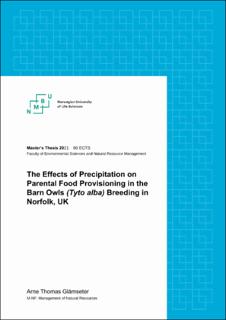| dc.description.abstract | Even though scientists have extensively studied the barn owl (Tyto alba), there is limited information on how climatic conditions influence parental food provisioning in barn owls on a local scale. Worsened climatic conditions imposed by global climate change may affect the population dynamics in barn owls, and barn owls may experience long-term population declines. I studied how precipitation influences parental food provisioning by using weather data obtained from weather stations and camera surveillance at barn owl nests during the breeding season (May-August) in 2019 in Norfolk, UK. Camera surveillance enabled monitoring of prey delivery rate and owl diet on the scale of hours throughout the breeding season. I found small mammals accounting for as much as 98% of the prey deliveries. The field vole (Microtus agrestis) was the most abundant prey species both by number
(38.5%) and mass (45.8%). Avian prey deliveries only occurred three times, whereas no deliveries of lizards, amphibians and invertebrates occurred. The probability of prey deliveries concerning the time of the day indicated a circadian activity rhythm and barn owls to be nocturnal hunters mainly. Prey deliveries peaked around midnight. The probability of prey deliveries from the families Arvicolidae, Muridae, and Soricidae, indicated a circadian rhythm and foraging primarily between sunset and sunrise. Prey was decapitated before delivery only on a few occasions, in five of 647 prey deliveries, with three of the five deliveries happening the same hunting night. As few studies have addressed the prevalence of decapitated prey before delivery, future studies may further explore this issue. Nestling feeding unassisted increased as the nestlings grew older. At the age of 18.6 days, it was 50% likely
that the nestlings ingested prey without maternal help. As the nestlings grew older, prey deliveries by the female became more likely, while the probability of prey deliveries inside the nest cavity decreased. The number of prey deliveries ranged from no deliveries up to 20 deliveries a day. On average, seven to eight prey items were delivered to the two nestlings in each nest, indicating that each nestling consumed three to four prey items each day. The number of prey deliveries at night decreased with increasing daily rainfall, implying that barn owls may limit hunting when it rains. An increase in prey deliveries during the daytime was related to the two last days of rainfall. Two days with rainfall compelled the owls to hunt during the daytime to provide enough food for the nestlings. Few prey deliveries the previous night was still the best explanation for an increase in daytime deliveries. My results suggest that precipitation must be considered an important factor when evaluating how weather conditions affect parental food provisioning. Further research on how weather conditions influence parental food provisioning in barn owls should also include other factors such as wind and temperature. Future studies exploring this issue will enhance our understanding of how barn owl populations will respond to more frequent extreme weather events in the future. | en_US |

